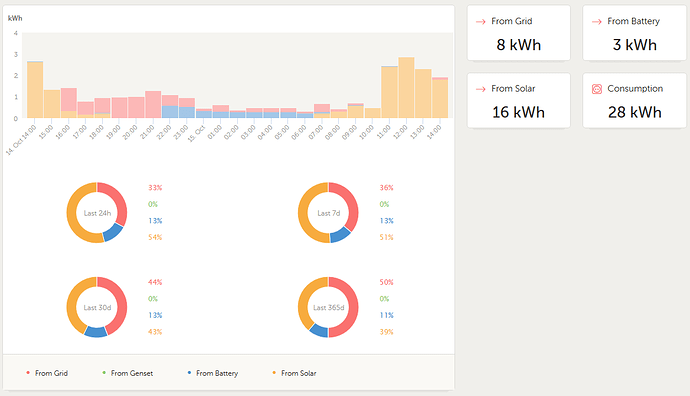Very good point …
… that is then sorted, no confusion left.
Right, let me explain where the reuqest stems from, Plonkster knows it is not from yesterday that I’ve been at this. 
Take any day cycle. Morning SOC is say 40%. ESS will get that back to as close to or to 100% SOC during the day, using the stored energy where and as needed, coupled with the sun.
100% with that, no problem.
However, no matter the size of the battery bank or array, one could look at it all and take a different arpproach because
- you want to have 100% SOC at say later afternoon for evening use and
- during peak hour generation, you don’t want batteries to assit powering loads for more than a couple of % points of the SOC.
Put differently, spread the battery use over a 24hour period, versus big loads working the batts hard for certain periods of the day.
Now one can say, get more batts, panels, match the 4kw the 5kva can do … but what if the loads are just on average 2.5kw peak times, I just don’t want to use the batts that hard?
Where does one draw the line?
So what I do, as the day progresses, I up the SOC, 40% - 45% - 50% manually so that by 11ish it is about i.e. 84% … cannot go to 85%, that will take Eskom to charge to ±86% SOC, so I Ieave it. That 4% down to 80% can be used by ESS during the peak load periods from 11am-3pm. So batts are not used too hard for extended periods driing the dayly cycle, just i.e. 4% as per the example.
After 3pm I get to back to 100% easily IF I start off with say 80% at 3pm.
From 16h30 I set a Scheduled Charge with SOC of 45% to not use any batts at all until 10pm.
So 95-100% SOC by 10pm is a guarantee, because that is when I want to use the batts again until solar takes over the next day powering the average loads.
The above is especially obvious in Cpt Winters where you want to crawl back up the SOC % for evening use, and not let the system stay at a low SOC for days. Rain and winter combined is a challenge.
If I increase the SOC based on a estimated SOC per hour via a Cronjob, 9/10 times I get it wrong and AC is used to recharge when I have more panels than what the daily loads need, with the right amount of batteries for the loads I have.
So Keep Charge with Solar will do similar, just never use AC, to get back to 100% for evening use.
For me, the goal is simple: Balance the array, the batts nicely over 24 hours.
Peak loads are Eskom peaks - costs cents on the rand and does nto give that good a ROI if any.
24/7/365 loads are 100% solar loads - THAT is where the ROI’s sit.



